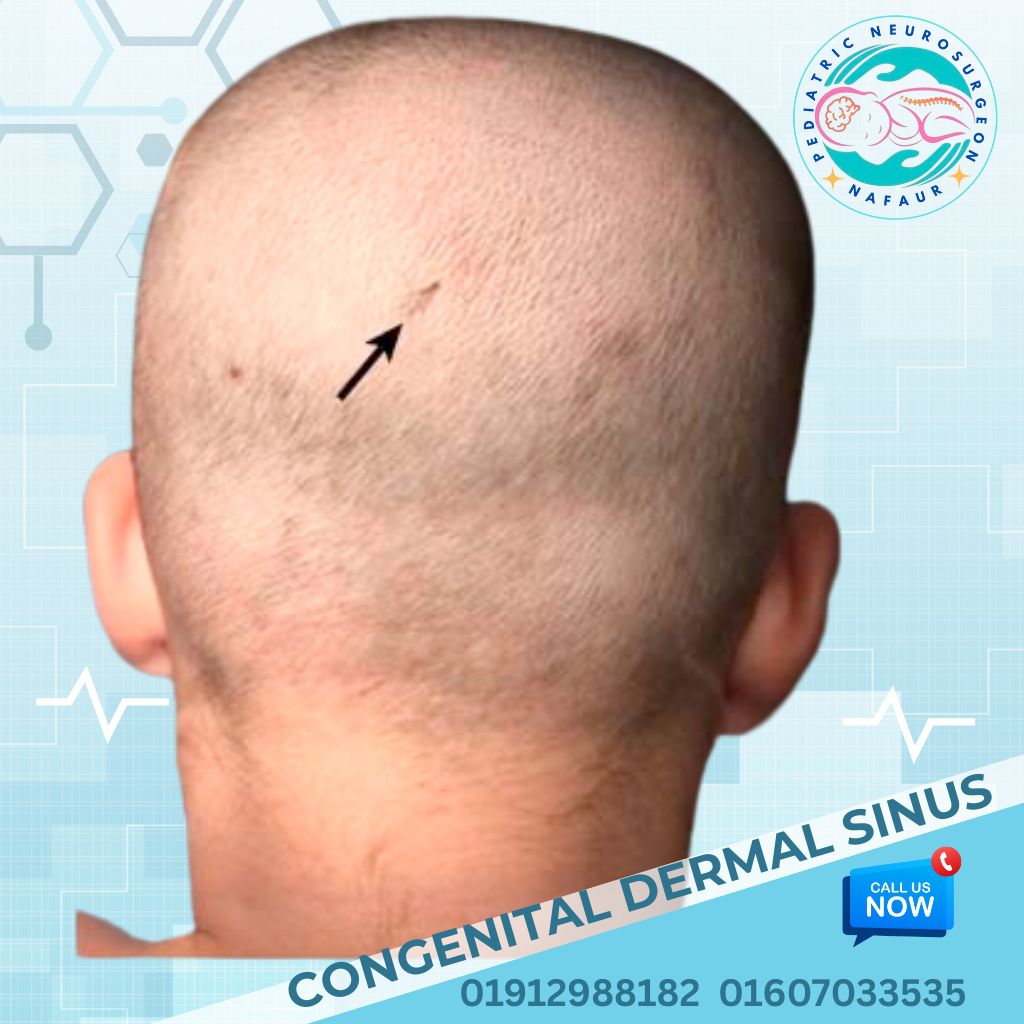Congenital dermal sinus
Congenital dermal sinus
Cranial congenital dermal sinus is a rare congenital neural tube defect, in which an abnormal epithelial-lined tract extends from the skin of the scalp down to the underlying dura, skull, or even the brain. These sinuses are typically located in the midline of the scalp, most commonly at the occipital or nasal region, and may remain unnoticed until complications such as recurrent infections, meningitis, or brain abscess occur. Unlike superficial skin pits, these sinus tracts may penetrate deep into the intracranial space, making early recognition and surgical treatment essential to prevent life-threatening infections or neurological damage. 🌍 Cranial Dermal Sinus in the Bangladesh Context In Bangladesh, many children with midline scalp dimples or pits are undiagnosed due to low awareness among parents and primary healthcare providers Superstitions and cultural practices often delay medical evaluation of visible scalp abnormalities in infants Misdiagnosis or delayed diagnosis leads to serious infections like meningitis, which can be fatal if untreated With advanced neurosurgical care now available at National Institute of Neurosciences & Hospital (NINS) and Bangladesh Paediatric Neurocare Centre, timely diagnosis and treatment are achievable Public health education and newborn screening could greatly reduce preventable complications ⚠️ Causes and Development Caused by incomplete separation of the neuroectoderm from the cutaneous ectoderm during embryonic development (3rd to 5th week of gestation) This results in a tract lined with epithelium extending from the skin surface into the intracranial space, sometimes connecting with the dura, arachnoid, or brain parenchyma May be associated with dermoid or epidermoid cysts, tethered brain tissue, or even vascular anomalies in some cases 🧒 Signs and Symptoms Visible midline dimple or pit on the scalp, often with a tuft of hair or surrounding discoloration Clear or purulent discharge from the sinus tract Swelling or a cystic mass under the scalp Recurrent scalp or intracranial infections such as meningitis, cerebritis, or brain abscess Neurological symptoms in advanced or untreated cases (e.g., irritability, seizures, altered consciousness) Signs of increased intracranial pressure in rare, complicated cases 🔍 Diagnosis and Imaging Clinical examination is the first step—any midline scalp lesion should raise suspicion MRI brain with contrast is the gold standard for identifying the full extent of the sinus tract and associated cysts or brain involvement CT scan helps visualize bony involvement or skull defects Swab cultures may help in cases with discharge to identify pathogens Early referral to a pediatric neurosurgeon is critical 🛠️ Surgical Treatment Options Surgical removal of the dermal sinus tract is the definitive treatment and aims to prevent infection and remove any associated intracranial pathology. Surgical Objectives: Complete excision of the entire dermal sinus tract Removal of associated dermoid or epidermoid cysts if present Repair of skull and dura if involved Prevention of future episodes of meningitis or brain abscess Preservation of neurological function Procedure Details: Surgery typically involves microsurgical dissection to ensure complete tract removal Dura repair may be needed if the tract communicates with subdural or subarachnoid space Infected cases may require antibiotic therapy before and after surgery Hospital stay ranges from 3–7 days depending on infection status and surgical complexity 🏥 Postoperative Care and Follow-Up Pain management and wound care Monitoring for signs of infection or CSF leakage Antibiotic coverage if surgery follows infection Follow-up MRI scans to confirm complete tract removal and assess healing Neurological assessments if any prior complications existed 🔄 Prognosis and Long-Term Outcome With early diagnosis and complete surgical excision, the prognosis is excellent Prevention of life-threatening complications like meningitis and brain abscess is the key benefit of early surgery Neurological function is typically preserved if treated before onset of complications Lifelong follow-up is not required unless there were associated anomalies or delayed treatment 👨⚕️ Why Choose Dr. Md. Nafaur Rahman? One of Bangladesh’s leading pediatric neurosurgeons in treating congenital brain and spine defects Extensive experience with cranial dermal sinus surgeries and associated brain cysts Operates at NINS, the country’s premier neurosurgical institute, and leads Bangladesh Paediatric Neurocare Centre Uses advanced imaging and microsurgical techniques ensuring safety and complete tract removal Offers holistic care: from prenatal counseling, diagnosis, surgery, to rehabilitation 📞 Schedule a Consultation for Cranial Dermal Sinus Dr. Md. Nafaur Rahman Assistant Professor, Department of Pediatric Neurosurgery, NINS Chief Consultant, Bangladesh Paediatric Neurocare Centre 📞 Call: 01912988182 | 01607033535 🌐 Visit: www.neurosurgeonnafaur.com












